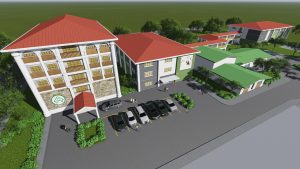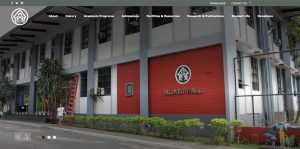
The UP College of Home Economics (CHE) inaugurated the newly renovated CHE Gusali 2 Building and held the groundbreaking ceremonies of the CHE Complex Phase 1 on Jun. 9 at the CHE grounds.
The complex composed of the CHE Museum and the Department of Family Life and Child Development (FLCD) building, with the Child Development Center (CDC), is a response to better serve the needs of CHE constituents, UP community and other stakeholders.
The CHE Gusali 2, a 2-storey building, underwent renovation from November 2015 until May 2016. The first floor has two big classrooms and a room allocated for the CHE Student Council. The second floor has a multi-purpose hall that has a seating capacity of 350 and can be converted into three big separate classrooms.
The CHE Complex Phase I (CHE Museum and FLCD building) designed and being built by the Architectural and Engineering Services is projected to be turned-over to CHE by May 31, 2017. It is funded by the General Appropriations Act of 2015.
UP CHE dean Aurorita T. Roldan said the upgrading of CHE’s infrastructure and facilities is the University’s effort in providing the faculty members, REPS, students and staff a nurturing and conducive environment to learning.
“The museum would highlight what is Filipino when it comes to the basic needs of a person particularly clothing, food, shelter and caring for the children and family relationships. With our new FLCD building, we could do more research and observations in the early childhood education and do more training and outreach programs.”
The CHE Museum will be a combination of traditional and modern Philippine architecture. It is a 4-story building with a mezzanine and has a total area of 2,093.78 square-meters.
The ground floor is intended for the student activity area and lecture halls.
The second floor will house the Home Economics Education Museum and FLCD Museum.
The Home Economics Education Museum is a collection of 260 pieces of traditional household equipment and utensils called Koleksiyon ng mga Tradisyunal na Kagamitang Pambahay. The Koleksiyon showcases the richness of Filipino culture and national identity by exhibiting the equipment used in the planning, preparation, preservation and serving of foods in different parts of the country. FLCD Museum, on the other hand, will contain traditional toys, books and other instructional materials used for children and early childhood education.
The third floor will be home to the collection of the Interior Design program such as miniature models of residential and commercial spaces, furniture and furnishings, and other interior design works of faculty members and students.
The museum’s fourth floor will have the collection of the Clothing Technology program which boasts of more than a thousand pieces of Filipino costumes and accessories such as shoes, bags, belts, veils, hats, etc. The collection, rare and authentic, represents a valuable segment of the historical development of styles of Filipino costumes. The museum serves as a laboratory for Clothing Technology majors.
The mezzanine area will be used as storage of the clothes and dress collections of the CHE.
Meanwhile, the FLCD buildings, with a total area of 3, 284.5 square-meters, are two 3-story structures connected by a deck bridge which also serves as observation deck overlooking the children’s playground.
The ground floor will be used by CDC, the laboratory school of FLCD. The existing concrete slides done by National Artist for Sculpture Napoleon Abueva will remain and shall be part of the indoor playground for children enrolled at CDC.
The offices of the Department including a library will occupy the second floor, while the third floor will be for the faculty rooms and classroom of FLCD majors.
The distinct feature of the building is that all classrooms, including the playground, will have an observation area/deck.

Meanwhile, CHE’s newly designed website was also launched during the reception. It has more comprehensive information about CHE and its department. All admission forms are now downloadable.
The new website is linked to DZUP and social media such as Facebook, Instagram and Twitter.
